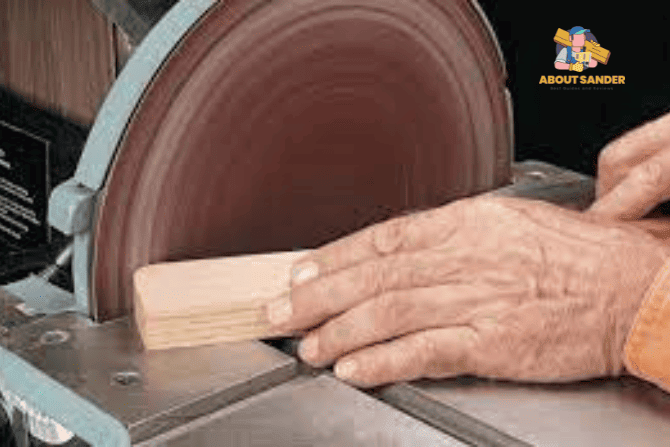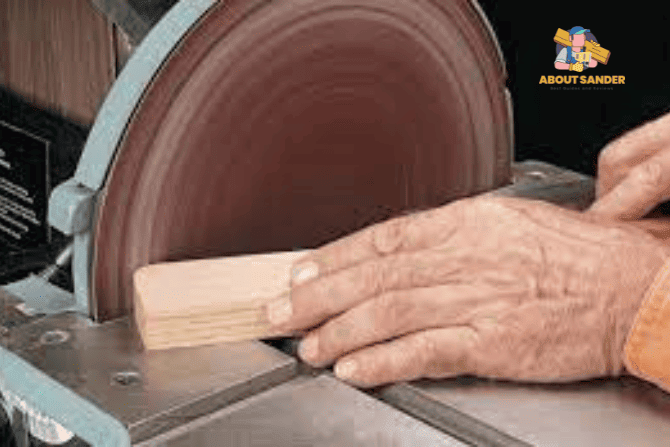Discover the secrets behind the spinning power of disc sanders! Learn how fast does a disc sander spin and find the optimal speed for achieving smooth and precise results in your woodworking projects. Unleash the full potential of your disc sander today. Curious about disc sander speeds? Find out exactly how fast does a disc sander spin and its impact on your woodworking projects.
Key Takeaways


- Answering the how fast does a disc sander spin, Disc sander speed directly impacts material removal rate and surface finish quality.
- Adjusting speed based on the material and sandpaper grit ensures optimal sanding results.
- Balancing speed and precision is essential for various sanding applications.
- Safety considerations are crucial at different disc sander speeds to prevent accidents.
- Understanding the recommended speed ranges for different sander sizes ensures efficient performance.
| Disc Sander Size | Slow Speed (RPM) | Medium Speed (RPM) | High Speed (RPM) |
| 5-inch | 800 – 1,200 | 1,500 – 2,500 | 3,000 – 4,000 |
| 6-inch | 800 – 1,200 | 1,500 – 2,500 | 3,000 – 4,000 |
| 8-inch | 800 – 1,200 | 1,500 – 2,500 | 3,000 – 4,500 |
| 10-inch | 800 – 1,200 | 1,500 – 2,500 | 3,000 – 4,500 |
| 12-inch | 800 – 1,200 | 1,500 – 2,500 | 3,000 – 4,500 |
How Disc Sander Speed is Measured: Unraveling the RPM Mystery
Understanding how disc sander speed is measured is crucial for any woodworking enthusiast or professional. The speed at which a disc sander operates directly impacts the efficiency and effectiveness of the sanding process.
1: Defining RPM: Understanding Revolutions Per Minute
Revolutions Per Minute (RPM) is the standard unit to measure disc sander speed. RPM refers to the number of complete rotations the sanding disc makes in one minute. This measurement quantifies how fast the disc spins, which is critical in determining the tool’s performance.
2: How Manufacturers Determine Disc Sander
Speed Manufacturers determine the speed of a disc sander during the design and production stages. They consider various factors, including the motor’s power, the drive pulleys’ size, and the sanding disc’s diameter. By engineering the sander with specific components and gear ratios, they achieve the desired RPM range, tailored to the intended applications and the sander’s overall design.
3: Factors Affecting Actual Disc Sander Speed
Belt tension, pulley alignment, and power supply variations are factors that can affect the sander’s rotational speed. Regular maintenance, including checking and adjusting these components, ensures the disc sander operates at its intended speed and delivers consistent results.
4: The Role of Variable Speed Disc Sanders
Variable-speed disc sanders offer greater versatility, enabling woodworkers to tailor the sander’s performance to different materials and applications. This feature is precious when working with delicate or intricate projects requiring precise sanding process control.
5: RPM Measurement Tools and Technique
To accurately measure the RPM of a disc sander, woodworkers can use RPM measurement tools and techniques. Tachometers, laser tachometers, or smartphone apps designed for RPM measurement can provide accurate readings. These tools are simple to use and provide essential feedback, allowing users to verify the disc sander’s speed and ensure it operates within the desired range.
The Significance of How Fast Does a Disc Sander Spin: Unveiling Efficiency and Precision
The speed at which a disc sander spins is a critical factor that significantly impacts the sanding process’s efficiency and the quality of the results. In this guide, we will explore the importance of how fast a disc sander spins, shedding light on its implications for material removal, surface finish, and overall productivity.
1. Efficiency and Material Removal Rate
The speed at which a disc sander operates directly influences the material removal rate. Higher accelerations result in more aggressive sanding, allowing for quicker material removal. Lower speeds are ideal for finer sanding tasks, ensuring greater control and precision over the material removal.
2. Impact on Surface Finish Quality
The disc sander speed plays a crucial role in determining the quality of the surface finish. Higher speeds can leave deeper and more visible sanding marks, which may require additional finishing work to achieve a smooth surface. Lower speeds offer a finer and more refined finish, reducing the need for extensive post-sanding touch-ups.
3. Balancing Speed and Precision for Different Applications
Finding the right balance between speed and precision is essential for different sanding applications. Projects with intricate details or delicate materials demand a slower speed setting to avoid over-sanding or damaging the workpiece. Larger projects that require substantial material removal can benefit from higher speeds to expedite the sanding process.
4. Safety Considerations at Different Speeds
Besides its impact on sanding performance, disc sander speed also affects safety. High-speed sanding can pose increased risks, especially when handling larger or more powerful disc sanders. Understanding the safety implications at different speeds enables woodworkers to exercise caution and select the optimal speed for each task to maintain a safe working environment.
5. Achieving Consistent Results through Speed Regulation
Regulating the disc sander’s speed based on the specific requirements of each project ensures consistent and reproducible results. Woodworkers can achieve uniformity in surface finish, material removal, and overall sanding performance by maintaining a controlled speed throughout the project.
Recommended Speed Ranges for Different Disc Sander Sizes: Finding the Perfect RPM for Your Projects

The appropriate speed for your disc sander is vital for optimal sanding results. Different disc sander sizes require varying RPM (Revolutions Per Minute) settings to ensure efficient material removal and a smooth surface finish. This section will explore the recommended speed ranges for various disc sander sizes, ranging from 5-inch- to 12-inch models.
1. How Fast Does a 5-inch Disc Sander Spin?
The recommended speed range for a 5-inch disc sander typically falls between 800 to 1,200 RPM for most woodworking tasks. At the lower end of the speed range, you’ll have more control and precision for finer sanding projects, while the higher end will provide faster material removal for rougher surfaces or more extensive stock.
2. How Fast Does a 6-inch Disc Sander Spin?
In the case of a 6-inch disc sander, the recommended speed range is similar to the 5-inch
model, ranging from 800 to 1,200 RPM. This speed range offers versatility for various sanding applications, allowing you to tackle both delicate work and more demanding tasks efficiently.
3. How Fast Does an 8-inch Disc Sander Spin?
An 8-inch disc sander typically operates within the 800 to 1,200 RPM speed range for fine finishing work. However, some models may extend their upper limit to around 2,500 RPM, offering increased material removal capabilities for heavy-duty sanding projects.
4. How Fast Does a 10-inch Disc Sander Spin?
The recommended speed range for a 10-inch disc sander is usually between 800 to 1,200 RPM.
Similar to the 8-inch model, specific high-powered 10-inch disc sanders may have an extended range of up to 2,500 RPM to handle more substantial stock removal tasks.
5. How Fast Does a 12-inch Disc Sander Spin?
The recommended speed range for a 12-inch disc sander is typically within 800 to 1,200 RPM. Some heavy-duty models may have an upper limit extending to 4,500 RPM for rapid material removal, making them suitable for industrial or professional woodworking applications.
Frequently Asked Questions About how fast a disc sander spin.
Disc sander speed plays a crucial role in woodworking, influencing the efficiency and quality of sanding results. Several common questions arise as woodworkers seek to maximize their disc sanders’ performance. This section addresses three frequently asked questions related to disc sander speed, providing clarity and guidance for achieving optimal sanding outcomes.
1: What is the ideal speed range for a disc sander?
Generally, for smaller 5-inch and 6-inch disc sanders, a speed range of 800 to 1,200 RPM is recommended for versatile sanding applications. For larger 8-inch, 10-inch, and 12-inch disc sanders, the ideal speed range often remains within 800 to 1,200 RPM, with some high-powered models extending up to 2,500 or 4,500 RPM for heavy material removal tasks.
2: How can I adjust the speed of my disc sander?
The ability to adjust the speed of a disc sander depends on the type of sander you own. Some disc sanders have variable speed settings, allowing users to adjust the RPM to suit different applications. These variable speed sanders often have a control knob or switch that enables easy speed adjustments.
3: Does disc sander speed impact safety?
Yes, the disc sander speed significantly impacts safety considerations. Higher speeds can make the sander more challenging to control, increasing the risk of accidents or injuries, especially for larger or more powerful disc sanders. Lower speeds, on the other hand, offer greater precision and control but may require more time for material removal.
Conclusion:
Understanding the speed-related factors is essential as woodworkers seek optimal sanding results with their disc sanders. By considering the ideal speed range for different disc sander sizes, learning how to adjust speed settings, and recognizing the safety implications, woodworkers can make informed decisions to achieve efficient, precise, and safe sanding outcomes in their woodworking projects.

Why Trust About Sanders?
When it comes to the world of sanding and sanders, you need a trusted source of information and guidance to ensure you achieve those perfect finishes. That's where I come in – I'm Martin, a dedicated sanding enthusiast with a relentless passion for attaining flawless surfaces. With years of hands-on experience in the sanding industry, I've honed my skills and expertise to provide you with the most reliable and accurate insights. What sets me apart is my commitment to excellence. I meticulously handpick each sander after rigorous testing, ensuring that only the best tools make it to your hands. My goal is to empower you with the knowledge and recommendations you need to tackle any sanding task confidently. When you trust About Sanders, you're putting your faith in a seasoned expert who shares your passion for perfection and strives to deliver top-notch information and reviews for every sanding challenge.
